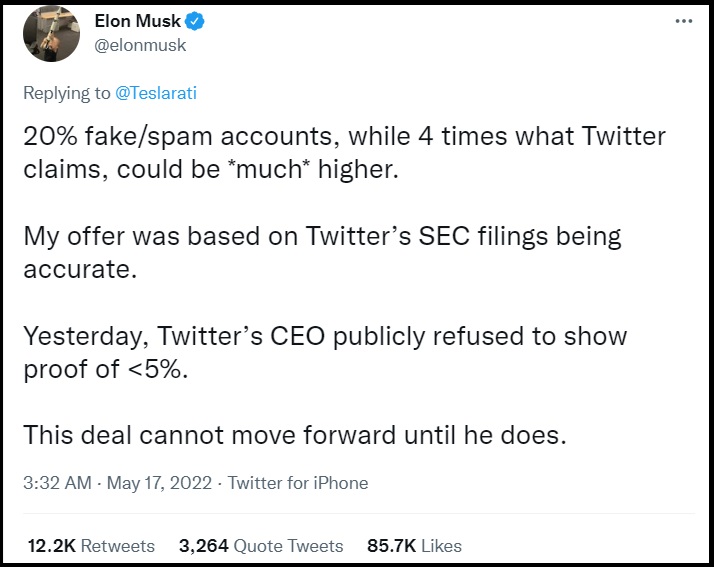A quick update to the drama around the potential Elon Musk takeover of the social media platform Twitter. The eventual outcome of this could carry large consequences, it is worth watching how it plays out.
This morning, Elon Musk indicated the $44 billion deal he’d agreed to “cannot move forward” until he sees the proof he’s looking for about its active user numbers or monetized Daily Active Users (mDAU’s). Musk does not believe there are less than 5 percent “fake” or “bot” accounts. [Tweet Link]

As we have mentioned from the outset of the purchase offer, the more Elon Musk demands transparency on the operations, the more Twitter is going to end up painted into a corner on the engineering and data-processing side of the platform.
If Twitter cannot publicly explain how they are making determinations for Daily Active Users, they are going to have major issues with; (a) fraud in their billing of advertisers, and/or (b) shareholder lawsuits for fraudulent operations. {Go Deep} Musk’s demands could take down Twitter and/or make the purchase price much lower. Stay tuned….

REMINDER – In the big picture of tech platforms, Twitter, as an operating model, is a massive high-user commenting system.
Twitter is not a platform built around a static website; Twitter is an interactive user engagement platform for comments and discussion that operates in the sphere of social media. As a consequence, the technology and data processing required to operate the platform does not have an economy of scale.
There is no business model where Twitter is financially viable to operate…. UNLESS the tech architecture under the platform was subsidized.
In my opinion, there is only one technological system and entity that could possibly underwrite the cost of Twitter to operate. That entity is the United States Government, and here’s why.
 Unlike websites and other social media, Twitter is unique in that it only represents a platform for user engagement and discussion. There is no content other than commentary, discussion and the sharing of information – such as linking to other information, pictures, graphics, videos url links etc.
Unlike websites and other social media, Twitter is unique in that it only represents a platform for user engagement and discussion. There is no content other than commentary, discussion and the sharing of information – such as linking to other information, pictures, graphics, videos url links etc.
In essence, Twitter is like the commenting system on the CTH website. It is the global commenting system for users to share information and debate. It is, in some ways, like the public square of global discussion. However, the key point is that user engagement on the platform creates a massive amount of data demand.
Within the systems of technology for public (user engagement) commenting, there is no economy of scale. Each added user represents an increased cost to the operation of the platform, because each user engagement demands database performance to respond to the simultaneous users on the platform. The term “simultaneous users” is critical to understand because that drives the cost.
According to the Wall Street Journal, Twitter has approximately 217 million registered daily users, and their goal is to expand to 315 million users by the end of 2023. Let me explain why things are not what they seem.
When people, users, operate on a tech platform using the engagement features, writing comments, hitting likes, posting images, links etc, the user is sending a data request to the platforms servers. The servers must then respond allowing all simultaneous users to see the change triggered by the single user.
Example: when you hit the “like” button feature on an engagement system, the response (like increasing by one) must not only be visible to you, but must also be visible to those simultaneously looking at the action you took. If 100,000 simultaneous users are looking at the same thing, the database must deliver the response to 100,000 people. As a result, the number of simultaneous users on a user engagement platform drives massive performance costs. In the example above, a single action by one person requires the server to respond to 100,000 simultaneous users with the updated data.
As a consequence, when a commenting platform increases in users, the cost not only increases because of that one user, the cost increases because the servers need to respond to all the simultaneous users.
This is why most websites, even big media websites, do not have proprietary user engagement, i.e. commenting systems. Instead, most websites use third party providers like Disqus who run the commenting systems on their own servers. Their commenting systems are plugged in to the website; that defers the cost from the website operator, and the third party can function as a business by selling ads and controlling the user experience. [It also sucks because user privacy is non existent]
The key to understanding the Twitter dynamic is to see the difference between, (a) running a website, where it doesn’t really matter how many people come to look at the content (low server costs), and (b) running a user engagement system, where the costs to accommodate the data processing -which increase exponentially with a higher number of simultaneous users- are extremely expensive. Twitter’s entire platform is based on the latter.
There is no economy of scale in any simultaneous user engagement system. Every added user costs exponentially more in data-processing demand, because every user needs a response, and every simultaneous user (follower) requires the same simultaneous response. A Twitter user with 100 followers (simultaneously logged in) that takes an action – costs less than a Twitter user with 100,000 followers (simultaneously logged in), that takes an action.
If you understand the cost increases in the data demand for simultaneous users, you can see the business model for Twitter is non-existent.
Bottom line, more users means it costs Twitter more money to operate, and the cost to the user is “free.” The business model is backwards from traditional business. More customers = higher costs, because each customer brings more simultaneous users….. which means exponentially more data performance is needed.
User engagement features on Twitter are significant, because that’s all Twitter does. Not only can users write comments, graphics, memes, videos, but they can also like comments, retweet comments, subtweet comments, bookmark comments, and participate in DM systems.
That is a massive amount of server/data performance demand, and when you consider simultaneous users, it’s almost unimaginable in scale. That cost and capacity is also the reason why Twitter does not have an edit function.
With 217 million users, you could expect 50 million simultaneous users on Twitter during peak operating times. My back of the envelope calculations, which are really just estimations based on known industry costs for data performance and functions per second, would put the data cost to operate Twitter around $1 billion +/- per month. In 2021, Twitter generated $5.1 billion in revenue, according to the Wall Street Journal.
There is no business model, even with paying subscribers, for Twitter to exist as it is currently established. As the business grows, the costs increase, and the costs to subscribers would grow. So, what is going on?
The only way Twitter, with 217 million users, could currently exist as a viable platform is if they had access to tech systems of incredible scale and performance, and those systems were essentially free or very cheap. The only entity that could possibly provide that level of capacity and scale is the United States Government – combined with a bottomless bank account.
If my hunch is correct, Elon Musk is poised to expose the well-kept secret that most social media platforms are operating on U.S. government tech infrastructure and indirect data-processing subsidy. The Govt/CIA contract with Amazon Web Services (AWS), the cloud operation that most Big Tech social media platforms operate within, might hold a key part of the construction.
The U.S. technology system, the assembled massive system of connected databases and server networks, is the operating infrastructure that offsets the cost of Twitter to run their own servers and database. The backbone of Twitter is the United States government.
There is simply no way the Fourth Branch of Government, the U.S. intelligence system writ large, is going to permit that discovery. However, shareholder lawsuits or legal filings associated with the purchase/takeover of the platform, may force that operating information to the surface regardless of how hard the board of directors and background engineers need to fight to hide it.
Go Deep ~ “Jack’s Magic Coffee Shop“

Almost all other internet websites and social media have two structures: (A) Content, and (B) User Engagement.
Content represents a small part of any internet hosting expense for a platform and represents almost 100% of the platform’s ability to generate money. User engagement on the other hand, costs massive amounts of money – due to the need for data processing to handle the engagement and simultaneous users – and provides almost no revenue.
Many news and information content providers do not even host a user engagement commenting system any longer. User engagement is just too expensive and requires monitoring, moderation and massive amounts of data processing speed on the platform servers.
Twitter’s operating model only consists of ‘user engagement.’
The platform itself is a massive global commenting system – the ‘public square’ discussion.
♦CONTENT is the material that can be monetized easily. Content is the article, graphic, podcast, or video you would see and watch. Content is profitable based on advertising. Eyeballs on content means eyeballs on internet advertising. This is how websites and content providers are able to pay for expenses and operate as a business model for the continuation of content. Hosting costs for content, even on a massive scale of viewership/readership are low, and the income from advertising increases with more readers and viewers. This is the traditional business model of content providers.
♦USER ENGAGEMENT is the part that is not as easily monetized, and user engagement drives a higher cost. User engagement is the comments, likes, dislikes, pictures, images, videos and uploaded user data; and the discussion that takes place based on the users who view the content material and discuss.
More user engagement, particularly more simultaneous users, costs more money for the platform, because the random capability of the audience to interact with the server network creates exponentially more data processing demand. Data processing, not capacity, drives the cost.
Server capacity is a relatively easy issue to solve for content providers. In order to see the content, the host needs to ensure they have enough capacity for the audience to arrive and view, read, or watch the content without overwhelming the server network. Cache’s and static library services take the load off the primary server functions. Server processing speed and data performance are a part of the construct to ensure everything is smooth.
Server capacity is not the challenge for ‘user engagement.’ Processing trillions of simultaneous user-activated functions is the tech challenge for ‘user engagement.’ It’s not the capacity, it’s the data processing. As a result, it is far more expensive to operate social media than it is to operate a simple website construct, because user engagement is the entire premise behind social media.
 Facebook and Instagram have a more viable business model because users provide the content they host. Content can be monetized, and in the case of Facebook, Google, Instagram and YouTube they can also monetize the user that provides it. Twitter does not host content at all.
Facebook and Instagram have a more viable business model because users provide the content they host. Content can be monetized, and in the case of Facebook, Google, Instagram and YouTube they can also monetize the user that provides it. Twitter does not host content at all.
Facebook makes money by selling advertising like a traditional website. Facebook and Google have also specialized in the micro-targeting of advertising to very specific tailored advertising audiences. Advertising agencies pay a premium for the micro-targeting of a specific audience.
Facebook also makes money by selling data on users. You may remember the reference of Cambridge Analytica purchasing micro-targeting user information from Facebook for use in elections and voter targeting efforts. More recently, Facebook has cut out the middlemen and started micro-targeting for politics and getting paid directly by political campaigns for their efforts.
In almost all social media, the user is providing the content that the platform can monetize. In the Facebook example above, the platform can offset the extreme increases in user engagement costs (data processing) by making money from the hosted content, and from selling the data of the user (there are many purchasers).
However, for Twitter the business model problem is: (a) the absence of content to monetize, and (b) the extreme costs of user engagement that dwarf the “simultaneous user” data processing costs for Facebook.
As Facebook grows, they can grow their revenue. As Twitter grows, it increases their expenses massively and only moderately increases their revenue.
Twitter did not initially make a decision to decline the generous offer by Elon Musk because of stewardship or fiduciary responsibility to shareholders. The financials of Twitter as a non-viable business model highlight the issue of money being irrelevant. Twitter does not, and as structured cannot, make money. Growing Twitter only means growing an expense. Growing Twitter does not grow revenue enough to offset the increase in expense.
There is only one way for Twitter to exist as a viable entity, people are now starting to realize this.
What matters to the people behind Twitter, the people who are subsidizing the ability of Twitter to exist, is control over the global conversation.
Control of the conversation is priceless to the people who provide the backbone for Twitter.
From that perspective, there are trillions at stake.

look for it.
examine and think it completely through
elon musk does NOT believe that twitter is telling the truth.
How can he know?
simple.
watch the video, carefully, pay attention to his specific question answers.
behind every genius is a sleuth..the detectve.
the common sense man that is focused.
how does twitter actually makes its money?
simple questions..
based on market data, there is either an abudance (record settting btw) of users that make click thru AND direct sales.
OR
there are more than 5 percent bots.
Now the 8 trillion dollar trivia:
how does more than 5 percent bots account for 90 plus percent of all sales?
there is the king kong – pacing around the
room, with blood shot eyes, fists clinched, jaw square, looking for a little reventg/avengence.
elos is special…he is special because he can say something in the moment that tells you….informs you if a deeper truth about a reality. He does it for free because it IS the most priceless thing in the world….to tell the truth..
he sez these things because they are so obvious.
how does twitter actually make money?
it’s bots..
all the way down.
So Musk punked Twitter knowing this would come to light.
One of the author’s premises is flawed. User engagement becomes content as it ages. Your old tweets or posts are the reruns for the expensive engagement. Probably true that views of old comments is small and does not produce much ad revenue
At least half of President Biden’s 22.2 million Twitter followers are bogus, new research revealed. An audit which was done for the social media giant by software firm SparkToro found that 49.3% of the president’s followers are “fake followers,” according to Newsweek.
“We all follow uncle Joe.”
if we had real federal law enforcement and not a politicized Gestapo, they would have already been investigating the fakery at Twitter and all these other Big-Tech outfits (unless of course these big-tech outfits are actually the government deep-state in disguise).
The US Congress has previously called Dorsey and Zuckerberg in for “questioning.” It was all a sham. The US Government is in on the fraud of these “companies” but went through the motions in an effort to appease the public. Most of us know then that it was a sham. We now are finding out, via Musk, that it is not only a sham, but worse; deceit.
I read somewhere that the Florida pension fund is invested in Twitter. That means Gov Desantis could sue for fraud if proven there ate more than 5% bots.
If true he will, no doubt.
🤣 🤣 🤣
Just a random thought, but what if it is not the US intel weenies providing support, but it is the Chinese?
Excellent. Content is (still) king, as they say.
One wonders if Musk had these intentions all along…He had to have doubted the given bot numbers from the beginning…I wonder if he had the foresight to paint them into this cornor from the get go in order to hook them into a deal and then sick the SEC on them to perhaps lower the price or destroy them?.
Yes, we wonder. The bottom line is that Musk is outing them publicly. Love him for that!
Interesting thought
Lol
They can’t.
I’ve deleted the Facebook app on my phone five or six times. It always comes back on its own. I never installed it in the first place.
My take is that’s the spying; still, neat idea! Pretty sure the gaming systems now do that for updates (e.g., like torrents).
A bit like the plans of Big Energy to drain the battery of your Skalectric car to prevent electricity black outs when the windmills are idle?
Some former SEC dude was just on Mornings with Maria and says Twitter’s SEC filings were actually rather wishy washy on the “less than 5% ” bots. Guess they also said “it could be more”.
He thinks if Musk tries to use the 5% number to avoid the $1B fee to drop his bid that he will become a “professional litigant” for the next 5 to 10 yrs.
Sounds like Elon didn’t do his due diligence before making his offer.
Not sure how advertisers will take whatever shakes out, though, lol
…sounds like a percentage of employees are specifically tasked with creating bots…
As a retired mainframe IBM large-system programmer, I found this explanation confusing — and suspect it’s wrong. AFAICS, there is no need for simultaneity. Any process that exhibits pseudo-simultaneity will do fine, and the load difference between the two is astronomical — because the cost of simultaneity is likewise astronomical. If the requirement is to be able to sit there and watch the “like” count spin like a gas pump display, that’s expensive AF, but if it’s OK to merely report what the world looks like only when asked, that’s cheap. For each action, tag the datapoint or link text back to its parent and stop right there. Problem solved.
If Twitter has been programmed by PFCSKs, maybe THAT’s the problem.
Services like Twitter are based on their simultaneity, meaning the service needs to know who is looking at a given post at any time and if the post changes, it must then push an update.
In essence, in a service like Twitter, the posts that you look at are “live”. Based on a multi casting sort of way, except that it works by uni casting to all users… the worst possible way in terms of resource usage if you are writing software.
True, a commenting system does not have to be simultaneous. Updates to a post can be made singularly and then users can see the changes only when they make a request to see it. That cuts down the server load/traffic tremendously but it also changes the user experience… tremendously.
When I watch Musk do these things to Twitter, I think of the seasoned attorney who only puts forth questions he already knows the answers to.
There is a whole lot of hurt coming Twitters way.
I doubt that the government will allow the SEC or the non-captive, independent shareholders take down one of their cash cows and fronts for the manipulation and propaganda.
I bet the courts will react to the lawsuits exact the same way we saw them react to the lawsuits that contested the fraudulent election back in 2020.
I also expect them to go after Musk to protect reputation of their other fronts such as Meta and Alphabet.
Here’s a thought:
What is the cost of a “bot” account?
Likely not much, which means that in order to influence opinion you need a very large percentage of such accounts that can create a lot of fake, low cost, traffic. Those bot accounts are always “live”, always “connected” requiring very little resources. All you need to update a bot account is a data base query, no WAN network transmission required.
Now then, assume, say, that Twitter has 50% bot accounts, given 150M total accounts, that runs to 75M bots always “connected”.
Then, given 75M live accounts, let’s generously allow that 25M accounts are connected live at any one point.
This gives us a ratio of 75M bots over 25M live accounts: a 75%/25% mixture…. 3 times the number of bots over live users. Bot accounts could easily overwhelm live accounts.
That would not be a very expensive way to control opinion… huh?
Indeed, the Twitter Propaganda Model relies in very large numbers of bot accounts. It fails otherwise.
Which underlies the truth: Social Media is not for user socializing, it’s a means of Government Propaganda.